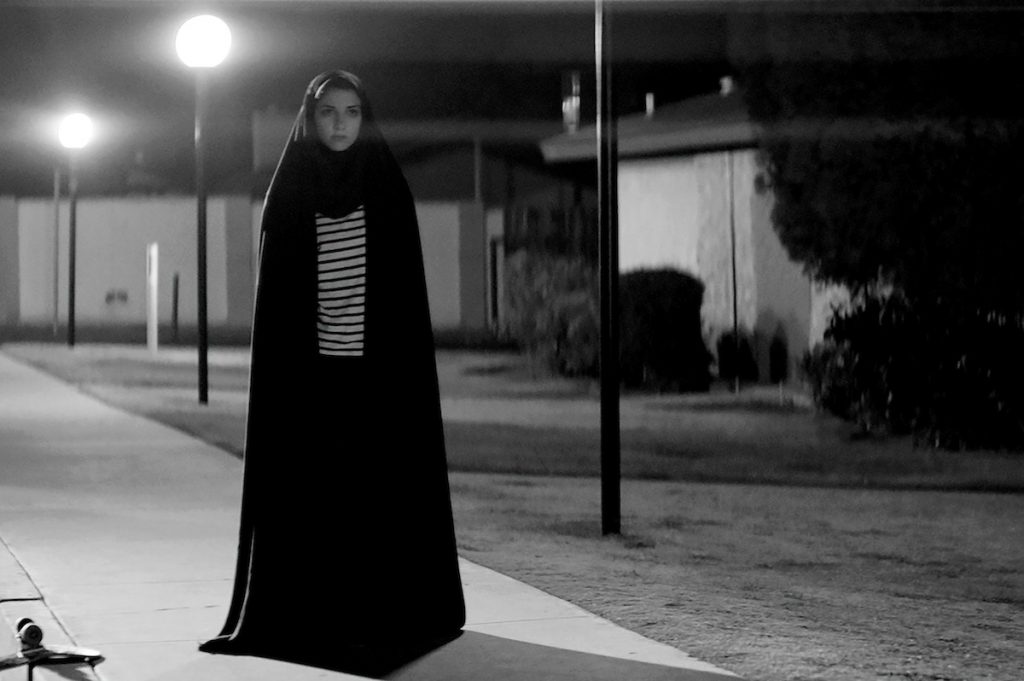Do we remember Diogenes of Sinope? Diogenes—the Greek cynic who famously wandered around holding a lantern up to all the men he passed in the marketplace, asking them, “Hey, are you full of shit?” Yes? We remember this? Good. Because that’s essentially the plot of A Girl Walks Home Alone at Night (Vice Films, 2014), only we’re in “Bad City,” Iran and it’s always nighttime and Diogenes has been recast as a vampire, and she—the titular “Girl” (Sheila Vand)—is dope as hell.
The film is the feature debut of director Ana Lily Amirpour, and it’s being heralded as the first “Iranian vampire western.” Maybe the need for all those modifiers is tantamount to what I’m about to say: that part of what’s so cool about A Girl Walks Home is the way it resists categorization, refuses to settle down neatly into any one genre camp. In fact, the way in which it’s most notably a western is the very thing that distances it from the historical vampire trope: the Girl’s victims are selected in accordance with strict vigilante justice** and not—as with most of vampire [FILL IN THE BLANK]—on the basis of whom she most wants to penetrate. And just think about that sentence for a second: “Whom she most wants to penetrate.” Already, we’re far from the vampires we’ve known—Dracula and Twilight and True Blood, the man in a cape leering over a woman asleep in her bed. It’s obvious, but it’s important and it bears stating: the Girl is a girl, and she comes to us self-made.
She also comes to us a little later on in the film and, of course, at night. By the time the Girl arrives on screen, we’ve already gotten the dramatic first act from which everything else will follow—the violent triangulation forming between the young male protagonist, Arash (Arash Marandi), his heroin-addicted father Hossein (Marshall Manesh), and Saeed (Dominic Rains), the drug dealer/pimp to whom they owe money. We’ve seen just how bad Saeed is, how brutally and cruelly he treats Atti (Mozhan Marnò), the prostitute who works for him. It’s this cruelty that seems to conjure up the Girl—our first glimpse of her comes during a scene of Saeed abusing Atti—and sets the rather spare plot in motion. The rest of the movie consists basically of the Girl going up to each of the male characters and asking, fangs out, “Are you a good boy?” (Spoiler: generally speaking, they’re not.)
I use the word “characters” here, but that’s a stretch; the people (and vampire) of Bad City aren’t so much characters as types. Even the ones who are given actual names (unlike “the Girl” or “the Street Urchin”) are never really allowed to outgrow the simplistic functions they’re assigned: dude, dude’s dad, pimp, prostitute, rich girl. This isn’t, however, a criticism. The plot is driven not by a complex weaving together of personalities, but by the inevitable, almost mechanical way these eight types—Bad City, POP 8—are destined to engage with each other. The eighth character—a gender queer cowboy who goes unaddressed in the course of the film but is apparently named “Rockabilly” (Reza Sixo Safai)—is even less of a “character” but is certainly more of a vision. Like a silent Greek chorus popping up exquisitely all over Bad City.
Just as there are no characters, there’s really no “place” to the film either—at least not in one sense: the setting is not so much “Bad City,” Iran as Bad City, “Iran.” Which is to say, while Iran is certainly evoked (everyone speaks Farsi, and it’s the Girl’s chador that becomes her vampire cloak), the movie ultimately resists any setting you could stick a thumbtack in. What we get instead is an incredible visual meditation on the very actual, very liminal spaces of a weird, perilous city: spaces at night, in corners, among shadows. Fences with holes so big you can lose a cat inside, empty streets, eerie power stations.
Once the Girl has cleaned Bad City of its bad actors, it’s perhaps unsurprising that the heroes—if they can be called that—leave. If the marketplace is cleared out, what good is it to our vigilantes? The film ends in flight, on an incredible final shot that conveys the precariousness of staying or going—of trying to find your way home at night. At the end, A Girl Walks Home leaves us asking, “What’s next?”
What’s next?
** The one exception being a random homeless man, because—I mean—a Girl’s gotta eat, and sometimes you’ve already snacked on all the bad dudes in town.
Image: Film Still, “A Girl Walks Home Alone at Night” (Vice Films, 2014)




